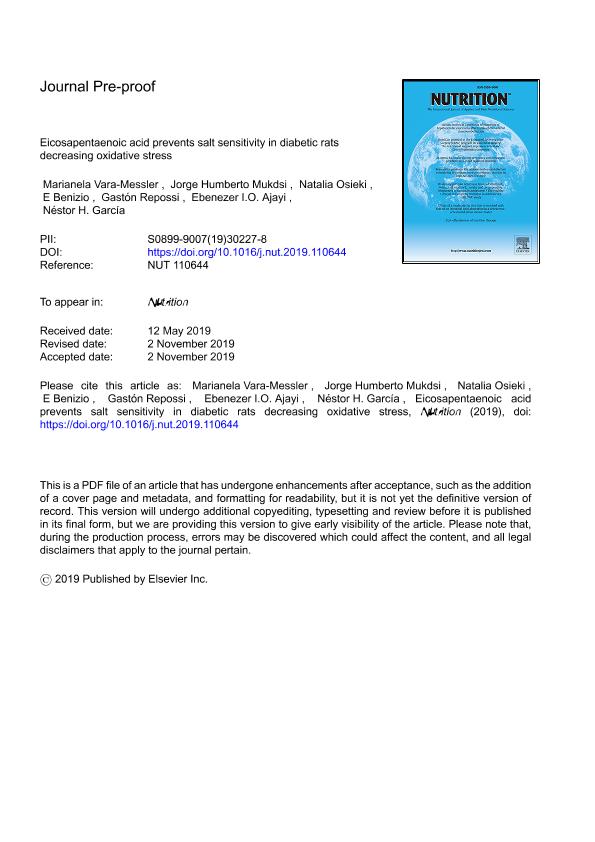Artículo
Eicosapentaenoic acid prevents salt sensitivity in diabetic rats and decreases oxidative stress
Vara Messler, Marianela ; Mukdsi, Jorge Humberto; Osieki, Natalia I.; Benizio, Evangelina Leticia
; Mukdsi, Jorge Humberto; Osieki, Natalia I.; Benizio, Evangelina Leticia ; Repossi Marquez, Pablo Gaston
; Repossi Marquez, Pablo Gaston ; Ajayi, Ebenezer Idowu O
; Ajayi, Ebenezer Idowu O ; Garcia, Nestor Horacio
; Garcia, Nestor Horacio
 ; Mukdsi, Jorge Humberto; Osieki, Natalia I.; Benizio, Evangelina Leticia
; Mukdsi, Jorge Humberto; Osieki, Natalia I.; Benizio, Evangelina Leticia ; Repossi Marquez, Pablo Gaston
; Repossi Marquez, Pablo Gaston ; Ajayi, Ebenezer Idowu O
; Ajayi, Ebenezer Idowu O ; Garcia, Nestor Horacio
; Garcia, Nestor Horacio
Fecha de publicación:
04/2020
Editorial:
Elsevier Science Inc
Revista:
Nutrition
ISSN:
0899-9007
Idioma:
Inglés
Tipo de recurso:
Artículo publicado
Clasificación temática:
Resumen
Objectives: Salt sensitivity (SS) is associated with increased cardiovascular risk in patients with Type 2 diabetes mellitus (T2-DM) due to an increase in renal oxidation. ω-3 polyunsaturated fatty acids have shown antioxidant effects, but a typical Western diet contains limited content. In particular, ω-3 polyunsaturated fatty acids are able to activate nuclear factor erythroid 2-related factor 2 (Nrf-2) to prevent diabetes mellitus–related complications by mitigating oxidative stress. Therefore, we hypothesized that eicosapentaenoic acid (EPA; ω-3) modulates SS in rats with T2-DM by decreasing renal oxidative stress via Nrf-2 activation and enhancing the antiinflammatory response via interleukin (IL) 6 modulation. Methods: Three-month-old male rats (n = 40) were fed with a Normal Na-diet (NNaD) and randomly selected into four groups: Healthy Wistar nondiabetic rats (Wi), diabetic controls (eSS), arachidonic acid-treated eSS (AA; ω-6), and EPA-treated eSS (ω-3). After 1 year, rats were placed in metabolic cages for 7 d and fed a NNaD, followed by a 7-d period with a High Na-diet (HNaD). Systolic blood pressure, body weight, serum IL-6 and reactive oxygen species (ROS) levels were determined at the end of each 7-d period. Glycated hemoglobin (HbA1c), triacylglycerol, creatinine, and cholesterol levels were determined. ROS levels and Nrf-2 expression in kidney lysates were also assayed. Histologic changes were evaluated. A t test or analysis of variance was used for the statistical analysis. Results: After a HNaD, systolic blood pressure increased in both the control eSS and AA groups, but not in the EPA and Wi groups. However, HbA1c levels remained unchanged by the treatments, which suggests that the observed beneficial effect was independent of HbA1c levels. The IL-6 levels were higher in the eSS and AA groups, but remained unaltered in EPA and Wi rats after a HNaD diet. Interestingly, EPA protected against serum ROS in rats fed the HNaD, whereas AA did not. In kidney lysates, ROS decreased significantly in the EPA group compared with the eSS group, and Nrf-2 expression was consistently higher compared with the AA and eSS groups. Diabetic rats presented focal segmental sclerosis, adherence to Bowman capsule, and mild-to-moderate interstitial fibrosis. EPA and AA treatment prevented kidney damage. Conclusions: An adequate ω3-to-ω6 ratio prevents SS in diabetic rats by a mechanism that is independent of glucose metabolism but associated with the prevention of renal oxidative stress generation. These data suggest that EPA antioxidant properties may prevent the development of hypertension or kidney damage.
Archivos asociados
Licencia
Identificadores
Colecciones
Articulos(INICSA)
Articulos de INSTITUTO DE INVESTIGACIONES EN CIENCIAS DE LA SALUD
Articulos de INSTITUTO DE INVESTIGACIONES EN CIENCIAS DE LA SALUD
Citación
Vara Messler, Marianela; Mukdsi, Jorge Humberto; Osieki, Natalia I.; Benizio, Evangelina Leticia; Repossi Marquez, Pablo Gaston; et al.; Eicosapentaenoic acid prevents salt sensitivity in diabetic rats and decreases oxidative stress; Elsevier Science Inc; Nutrition; 72; 110644; 4-2020; 1-32
Compartir
Altmétricas



